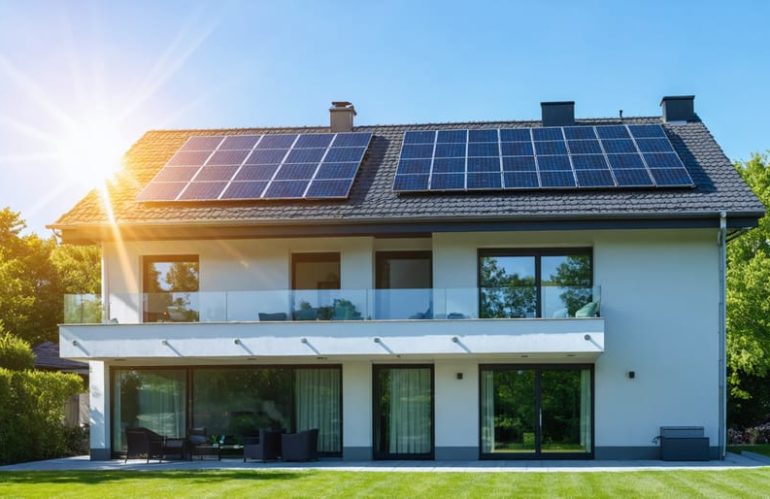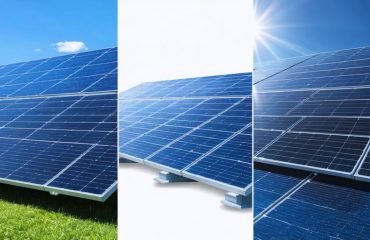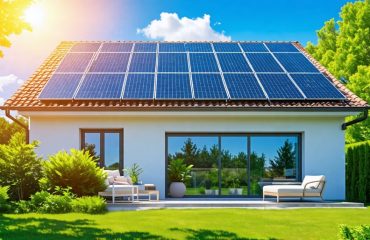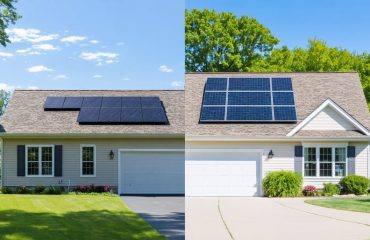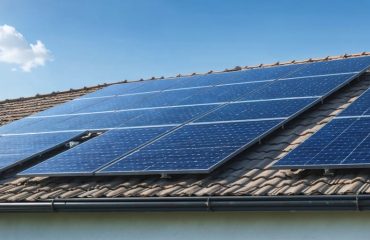The rise of solar technology has created an intriguing choice for homeowners: stick with traditional solar panels or embrace the newer, more aesthetically pleasing solar shingles. As energy costs continue to climb and climate concerns take center stage, both options offer compelling paths to sustainable, cost-effective home power generation. While conventional solar panels have dominated the market for decades with proven reliability and maximum energy output, solar shingles are revolutionizing the industry by seamlessly integrating renewable energy into your roof’s design. This guide cuts through the complexity to help you understand the key differences between these technologies, from initial costs and installation requirements to long-term energy production and return on investment. Whether you’re building a new home or upgrading your existing roof, understanding these distinct approaches to solar power will empower you to make the best choice for your specific situation and energy goals.
What Are Solar Shingles and Traditional Solar Panels?
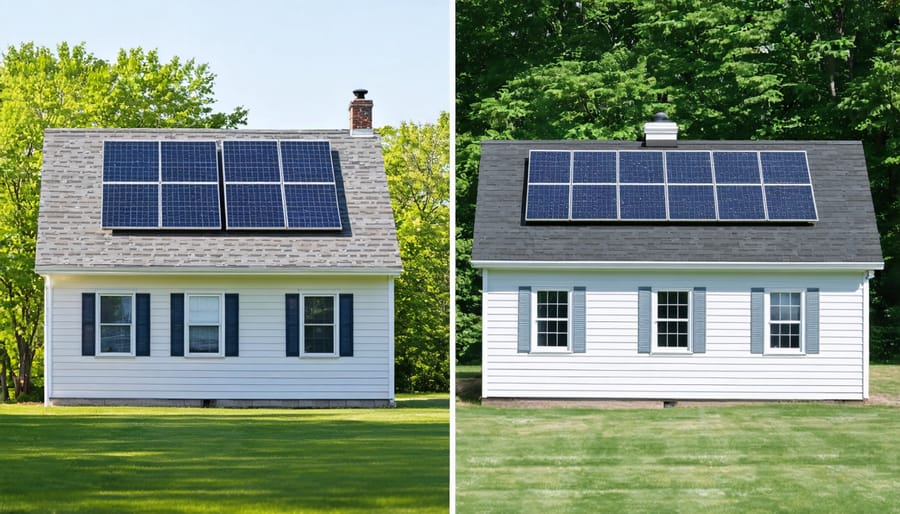
Solar Shingles Explained
Solar shingles, also known as photovoltaic shingles, represent an innovative solution that combines traditional roofing materials with solar technology. These sleek, roof-integrated products look like regular shingles but contain thin solar cells that convert sunlight into electricity. Unlike bulky solar panels, they become part of your roof’s structure, offering both protection from the elements and energy generation capabilities.
Each shingle contains photovoltaic cells made from semiconductor materials that create an electric current when exposed to sunlight. They’re installed similarly to traditional roofing materials, overlapping to create a weatherproof seal while forming an interconnected solar array. The generated electricity flows through hidden wiring systems to an inverter, which converts it into usable power for your home.
Modern solar shingles are designed to withstand various weather conditions and typically last 20-30 years. They’re particularly appealing to homeowners who want solar power without compromising their roof’s aesthetics. While they may be less visible than traditional panels, they still provide significant energy production capabilities, helping reduce electricity bills while maintaining your home’s curb appeal.
Traditional Solar Panels Explained
Traditional solar panels are the most common and well-established option for residential solar power. These panels consist of photovoltaic cells arranged in a grid pattern, typically encased in a sturdy aluminum frame with a glass cover. Each panel measures approximately 65 by 39 inches and can weigh around 40 pounds.
Installation involves mounting these panels on your existing roof using a racking system. The panels are secured above your shingles, creating a gap of several inches between the panels and your roof surface. This design allows for airflow, which helps maintain panel efficiency and protects your roof.
Most residential installations use monocrystalline or polycrystalline panels, with monocrystalline being more efficient but slightly more expensive. A typical home installation includes 20-24 panels, though this varies based on your energy needs and available roof space.
The panels connect to an inverter system that converts the DC power they generate into AC power your home can use. While the panels are visible on your roof, modern designs are sleeker and more aesthetically pleasing than earlier models, with all-black options available for a more sophisticated look.
Cost Comparison
Initial Investment
When comparing photovoltaic shingles and traditional solar panels, the initial investment is often a crucial factor in decision-making. Traditional solar panel installation costs typically range from $15,000 to $25,000 for an average-sized home, while solar shingles can cost between $30,000 and $60,000 for similar coverage.
The higher cost of solar shingles reflects their dual functionality as both roofing material and solar technology. However, it’s important to note that if you need to replace your roof anyway, the cost difference becomes less significant since solar shingles eliminate the need for separate roofing materials.
Traditional solar panels offer more flexibility in terms of initial investment, as you can start with a smaller system and expand later. Solar shingles generally require a complete roof installation, making partial installations less practical.
Both options qualify for federal tax incentives and local rebates, which can significantly reduce your upfront costs. The 30% federal tax credit applies to both systems, potentially saving thousands on your initial investment. Some states and utilities offer additional incentives that can further offset the installation costs.
Keep in mind that while the initial investment for solar shingles is higher, their aesthetic appeal and potential impact on home value might justify the extra cost for many homeowners.
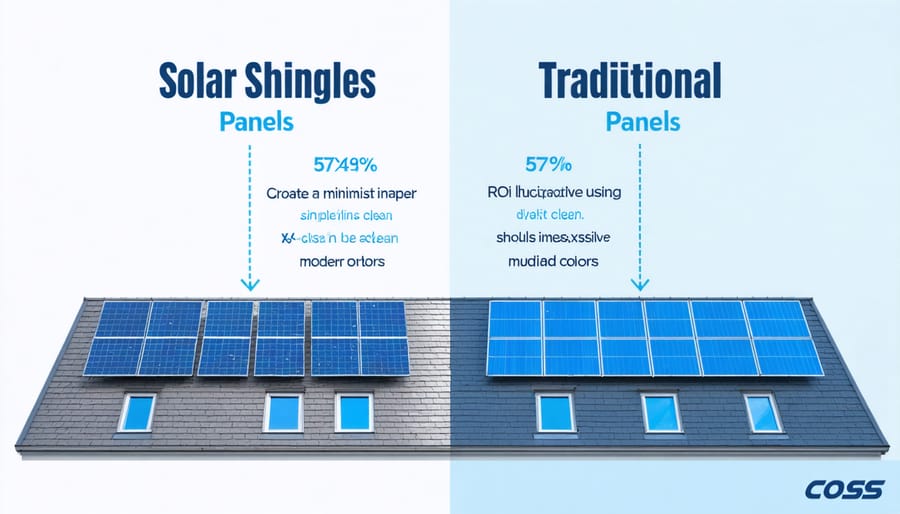
Long-term Value and ROI
When evaluating the long-term value of your solar investment, both photovoltaic shingles and traditional solar panels offer substantial returns, though their payback periods differ. Traditional solar panels typically provide a faster return on investment, with most homeowners recouping their initial costs within 5-8 years. Solar shingles, while having a higher upfront cost, generally take 8-12 years to reach the break-even point.
However, both options continue generating value long after the payback period. Solar panels have a proven track record of lasting 25-30 years, while solar shingles are designed to function both as roofing material and power generators for 20-25 years. When you factor in rising electricity costs, the long-term savings become even more significant.
Beyond direct energy savings, both systems can increase your home’s resale value. Solar panels typically add 4-6% to your home’s value, while solar shingles might command a slightly higher premium due to their aesthetic appeal and dual functionality.
Consider also the various incentives available. Federal tax credits, state rebates, and local incentives apply to both options, though the exact amounts may vary. Some utility companies offer additional rewards for solar adoption, further improving your return on investment.
Remember that maintenance costs are generally lower for traditional panels, which can affect your total returns over time. While both options provide excellent long-term value, your specific circumstances will determine which offers the better financial return.
Performance and Efficiency
Energy Output
When it comes to energy output, traditional solar panels generally have the upper hand. A typical solar panel can produce between 250-400 watts per panel, while solar shingles typically generate 50-114 watts per shingle. However, you’ll need more shingles to cover the same area, which can help balance out the total power generation.
Solar panels are more efficient at converting sunlight into electricity, with most modern panels achieving 15-20% efficiency. Solar shingles currently operate at slightly lower efficiency rates, usually between 14-18%. This difference is primarily due to their design constraints and the fact that they can’t be angled optimally like traditional panels.
The placement flexibility of traditional panels allows homeowners to maximize energy production by installing them at ideal angles and orientations. Solar shingles must follow your roof’s existing slope, which might not be optimal for solar collection. However, recent technological advances have significantly improved solar shingle efficiency, and some newer models are approaching the performance levels of traditional panels.
Keep in mind that actual energy output depends on various factors, including your location, roof orientation, local weather patterns, and shade conditions.
Durability and Lifespan
When it comes to durability, both photovoltaic shingles and traditional solar panels are built to withstand harsh weather conditions. Solar panels typically come with warranties ranging from 25 to 30 years, with many systems continuing to perform effectively for 30-40 years with proper maintenance. They’re designed to handle heavy snow loads, hail, and high winds, though they may require occasional cleaning and inspection.
Solar shingles, while relatively newer to the market, are engineered to be just as durable as traditional roofing materials. They generally come with 20-25 year warranties and serve a dual purpose as both roofing material and power generator. Since they’re integrated into your roof, they’re less likely to suffer damage from wind uplift compared to mounted panels.
Maintenance requirements differ slightly between the two options. Traditional solar panels may need periodic cleaning to remove dirt and debris, which can be done with water and a soft brush. Solar shingles typically require less maintenance since they’re installed at the same angle as your roof, allowing rain to naturally clean them. However, if repairs are needed, replacing individual solar shingles can be more complex than fixing traditional panels, as they’re integrated into the roofing system.
Installation and Maintenance
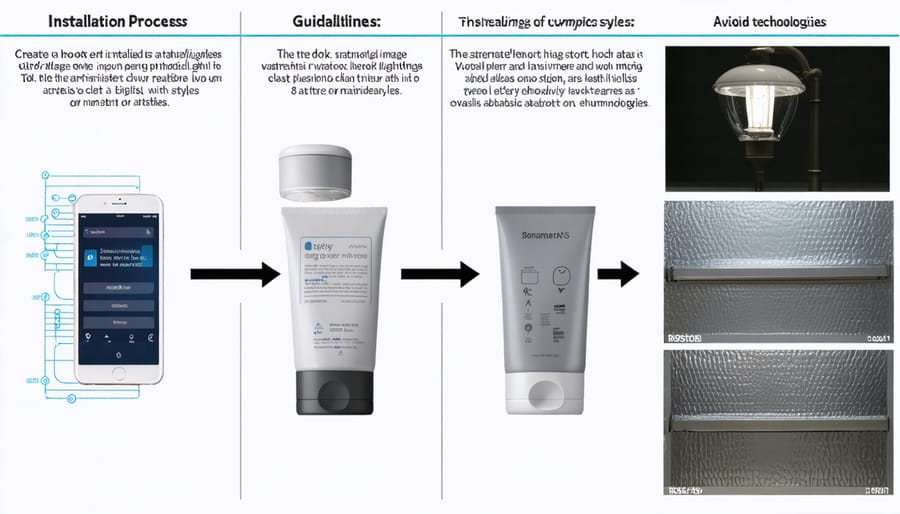
Installation Process
The installation process differs significantly between traditional solar panels and photovoltaic shingles. Solar panels typically require a 1-3 day installation period, with professionals mounting brackets and panels onto your existing roof. The process is straightforward and well-established, making it a reliable choice for most homeowners.
In contrast, solar shingles demand a more comprehensive approach, often taking 5-7 days to install. This longer timeline is because solar shingles replace your existing roofing material entirely, requiring careful integration with your roof structure. However, if you’re already planning a roof replacement, this timing aligns perfectly with your renovation needs.
Both options require professional installation by certified contractors. Solar panel installation can usually begin immediately, while shingle installation might need more extensive planning and permitting due to its role as both roofing material and power generator.
Weather conditions can impact both installation processes, but solar shingles are particularly sensitive during installation as they require specific temperature and weather conditions for proper adhesion and sealing. Your contractor will help determine the best installation timeline based on your local climate and specific roof requirements.
Maintenance Requirements
Both solar panels and photovoltaic shingles require relatively minimal maintenance, though there are some key differences to consider. Traditional solar panels typically need annual cleaning to remove dust, leaves, and debris, which can be done with a garden hose or soft brush. You may want to protect your solar installation from birds and other wildlife that might nest underneath.
Solar shingles, being integrated into your roof, generally require less frequent cleaning since they sit flush with the surface. However, when maintenance is needed, it can be more complex because the shingles are part of your roofing system. This means repairs might require both solar and roofing expertise.
Both systems should be inspected annually by a professional to ensure optimal performance. While panels can be easily replaced individually if damaged, replacing damaged solar shingles might involve more extensive roof work. Snow removal is typically easier with traditional panels, as their tilted installation helps snow slide off naturally, while solar shingles may need more attention during winter months.
Making Your Decision
When deciding between photovoltaic shingles and traditional solar panels, several key factors should guide your choice. First, consider your roof’s current condition and timeline. If you’re already planning a roof replacement, solar shingles might be more cost-effective as they serve dual purposes. However, if your roof is in good shape, traditional panels could be your best value solar solution.
Your budget plays a crucial role. While solar shingles typically cost more upfront, they might save money in the long run by eliminating separate roofing costs. Traditional panels, though less expensive initially, require additional mounting hardware and installation considerations.
Climate and sun exposure in your area should influence your decision. Traditional panels can be adjusted for optimal angle and positioning, potentially capturing more sunlight. Solar shingles, being fixed to your roof’s existing slope, may produce less energy in certain configurations.
Aesthetic preferences matter too. If maintaining your home’s architectural appeal is a priority, solar shingles offer a more integrated, seamless look. Traditional panels, while more noticeable, have become sleeker and more attractive in recent designs.
Consider your timeline as well. Traditional panels typically install faster and are readily available from numerous manufacturers. Solar shingles might involve longer wait times and fewer contractor options in your area.
Finally, think about future maintenance and warranties. Traditional panels are easier to repair or replace individually, while solar shingles might require more extensive work if issues arise. Check warranty coverage for both options, including performance guarantees and protection against leaks or damage.
Both photovoltaic shingles and traditional solar panels offer compelling paths to sustainable, energy-efficient homes. While solar panels remain the more established and cost-effective choice for most homeowners, solar shingles present an attractive alternative for those prioritizing aesthetics and roof integration.
Solar panels typically offer higher efficiency rates and lower initial costs, making them an excellent choice for budget-conscious homeowners seeking maximum energy production. Their proven track record, widespread availability, and easier maintenance continue to make them the go-to option for many solar installations.
However, solar shingles shine in situations where architectural aesthetics are paramount or when a roof replacement coincides with solar installation plans. Though currently more expensive, their seamless integration and improving technology make them an increasingly viable option, especially for new construction or complete roof renovations.
Your choice should ultimately depend on your specific circumstances. Consider your budget, roof condition, local climate, aesthetic preferences, and energy needs. If maximum power output and cost-effectiveness are your priorities, traditional solar panels are likely your best bet. If you’re willing to invest more for a sleek, integrated look and are planning a roof replacement anyway, solar shingles could be the perfect solution.
Remember that both options contribute significantly to reducing your carbon footprint and energy bills while increasing your home’s value. Whichever you choose, you’re making a positive step toward sustainable living.

